What end game in chess is more challenging than the queen versus rook? Without prior study or experience in this type of end game, even a grandmaster can fail to win with a king-and-queen against a king-and-rook, especially if the opponent is another grandmaster.
Philidor Position (not to be confused with a rook-and-pawn end game by that name)
No grandmaster should have much difficulty winning a Philidor position of the queen-versus-rook, however. With defender on the move*, the attacker should win easily, for there are more ways than one to drive home the victory. Let’s examine easily-remembered principles in this special case of a corner-defense in this type of end game. *(With attacker on the move a triangulation maneuver can transfer the move to the defender; that’s covered elsewhere.)
Not all endgame chess books cover the queen-versus-rook, but the many online resources, including many Youtube videos by Derek Grimmell, prove that many strategies and tactics are available to both the attacker and defender. In addition, even when the attacker plays well, a win does not necessarily come through a Philidor position. Other corner and edge patterns may be available to the attacker, not to mention forking the rook when there never was a Philidor on the board.
.
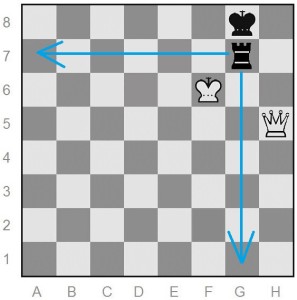
Diagram-one – Black to move – the Philidor position
Long rooks-moves*—that’s what the defender needs, for the one king-move available would result in the queen pinning and winning the rook. Short rook-moves also fail quickly, the most picturesque being Rh7; Qe8#. *(By “long,” we’re talking about Rg1 and Ra7.)
Both of those rook moves are answered by the same queen move: Qd5+ in Diagram-one. Here’s an easy way to remember the best move in whichever of the eight possible Philidor positions you might encounter in the four corners:
Two of the four center squares are available to the queen. Move it to the center square that checks the defending king. It’s that simple. (In other words, If the position is a classic Philidor, move the queen four squares towards the center and it will check the defending king.)
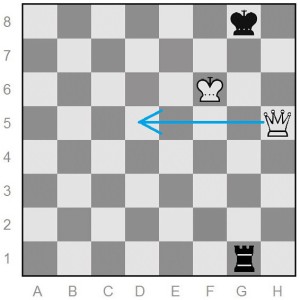
Diagram-two – the queen should move to d5 (check)
This is not the only way to win. Moving the queen to e8 first, and then to d7, c8, c7, b8, and a7 will eventually fork the rook, but it takes longer. Diagram-two shows the basic principle: The queen moves to a center square that makes a check.
.

Diagram-three – after Qd5+ and Kh7
Diagram-three shows that White moved Qd5+, and Black made the best move: Kh7. It invites White to make the blunder of Qb7+, for after Kh6 White will have no reasonable check available.
By the way, in positions arising from the queen-vs-rook Philidor, the defending king cannot hide in the corner behind its rook, as long as the queen is on the appropriate diagonal. For example, with the black king on h8 and the rook on g8, the queen (on the a8-h1 diagonal) would move to h1, which is checkmate.
So what should White aim for in Diagram-three? Notice that if the queen were on a8 (still on that long diagonal), Qa7+ would fork the rook. Remember that Qb7+, from Diagram-three, would be a mistake, for it allows the black king to hide behind the white king by moving Kh6. So how does White force the black king onto the eighth rank, allowing the queen to check with Qa8+ and then fork the rook with Qa7+? First move Qe4+.
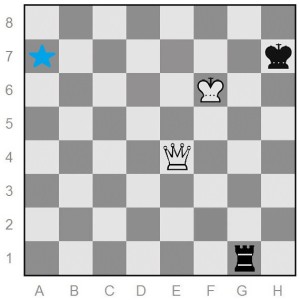
Diagram-four – showing the key square for the queen: a7 – Black to move
Notice that Black must move the king to the eighth rank, for Kh6 allows Qh4#. Remember, too, that the king cannot hide in the corner, with the rook shielding it by moving Rg8 (after Qa8+), for the queen is on that long diagonal: Qh1-mate. White’s next move, in Diagram-4, will surely be Qa8+, followed by Qa7+, forking the rook. This is a good time for the defender to resign.
Most chess books on the end game probably give little, if any, attention to the queen-vs-rook, although it occasionally comes up in master games. How might it come up? If each side has one rook and one advanced pawn, a rook might sacrifice itself capturing an enemy pawn, allowing its companion pawn to promote safely. That would give one side a queen and the other, a rook.
Let’s now consider the other long rook-move from Diagram-one: Ra7.
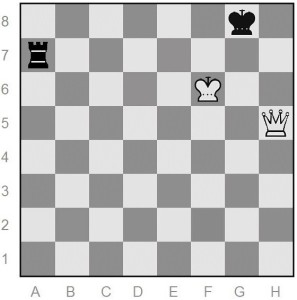
Diagram-five – From the original position: Ra7
What if, from the original Philidor position, the rook moves as far away from the queen as possible, in this case to a7? White still moves the queen to that central square: Qd5+. But now the forking of the rook is even quicker. After the black king moves out of check, to the h-file, White will move Qh1+ and the next move will surely be Qg1+, winning the rook. In Diagram-five, the key square is g1, similar to the key square being a7 if the rook is on g1.
What if, from Diagram-one, the rook moves to c7 or to g3? The key squares may be different, but the queen can still hunt down that rook and fork it. Either way, Qd5+ still works. It’s easier to see the key square when the rook’s at c7, for when the black king must move to the eighth rank then d8 is the forking square. But what if the rook, from Diagram-one, moves to g3?
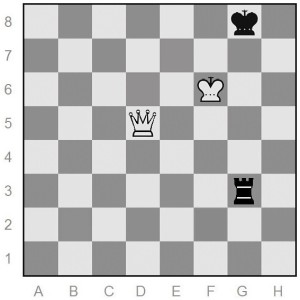
Diagram-six – From the Philidor, the moves were Rg3 and Qd5+
Black must now move to the h-file. It would be nice for the queen to then be able to land on h4 would it not? The queen could fork the rook at h4 but only when the black is on the h-file. Can the queen be repositioned to the fourth rank, while keeping up checks? Yes it can, but it requires a bit of foot work. From Diagram-six, consider the following moves:
1) . . . . Kh8
2) Qa8+ Kh7
3) Qe4+ Kg8 (Kh8 would allow an immediate Qh4+)
4) Qc4+ . . . . keeping an eye on h4 and preventing Kf8 because of Qc8#
4) . . . . Kh8 (or Kh7)
5) Qh4+ wins the rook
That’s not the only way to win. White could aim for the b8 forking square, in fact it’s quicker. But the above method illustrates one way to think in finding a winning solution. Find a worthy goal and search for how to obtain that victory.
.
###
.
I found several publications that could be very beneficial for children.
Philidor End Game of Queen Versus Rook
In the queen-versus-rook Philidor, the defending king has only one legal move, and it results in the queen pinning the rook and capturing it on the next move.
New Chess Book for the Beginner
How few [chess books] concentrate on what the early beginner needs the most! “Beat That Kid in Chess” differs by emphasizing the simple basics that give the biggest rewards, so you’ll quickly make real progress.
Various endgame resources
How Does Chess Benefit Children?
Test scores improved by 17.3% for students regularly engaged in chess classes, compared with only 4.6% for children participating in other forms of enriched activities.
.



